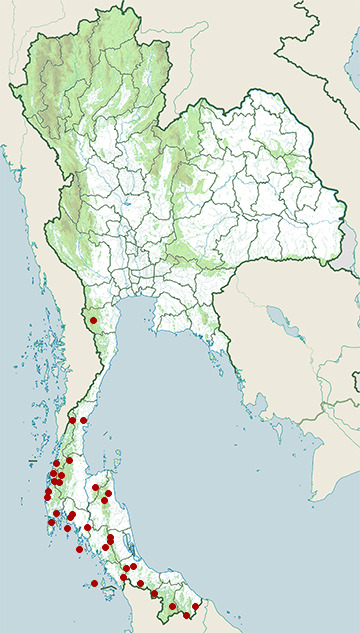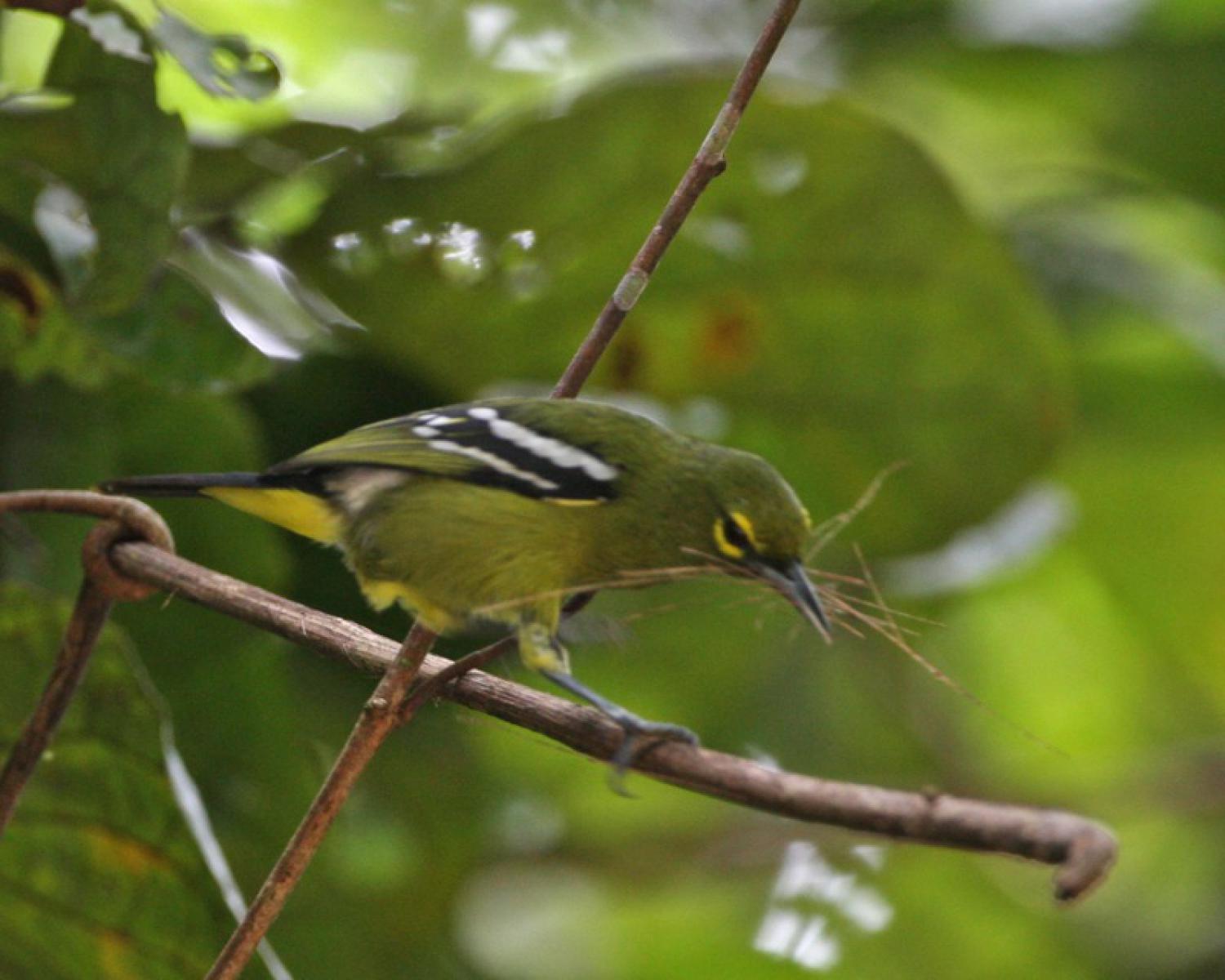Species of Thailand
Green iora
Aegithina viridissima
Charles Lucien Bonaparte, 1851
In Thai: นกขมิ้นน้อยสีเขียว
The green iora (Aegithina viridissima) is a species of bird in the family Aegithinidae. It is found in the Thai-Malay Peninsula, Sumatra and Borneo. Its habitats include lowland forests, secondary forest and mangrove forest. It is threatened by habitat loss, and the International Union for Conservation of Nature (IUCN) has assessed it as near-threatened.
Taxonomy
This species was described as Jora viridissima by Charles Lucien Bonaparte in 1850. Harry C. Oberholser described subspecies Aegithina viridissima thapsina from the Anamba Islands in 1917, noting its larger size and yellower plumage. These two subspecies are recognised by the IOC World Bird List, while Aegithina viridissima nesiotica described by Oberholser in 1912 is now included in the nominate subspecies.
Description
The green iora is 12 - 14 cm long. The male has black lores and bright yellow "eyelids" (a broken eye-ring). The face and upperparts are dark olive. The wings are black, with two white wing-bars on the covert feathers and olive-yellow margins on the flight feathers. The underparts are also dark olive, with lighter flanks and a yellow centre belly. The tail is black. The eyes are dark to red brown, the beak is grey-blue, and the feet are slaty blue. The female has yellow lores and a complete eye-ring. The upperparts and tail are medium olive. The wings are similar to those of the male but are washed olive, and the wing-bars are yellow instead. The underparts are olive green, with a yellow tint on the centre belly. The juvenile bird is similar to the female, but is paler.
Distribution and habitat
This species is found in Tenasserim, the Thai-Malay Peninsula, Sumatra, Borneo and some small neighbouring islands, and it is locally extinct in Singapore. It lives in the canopy of lowland forests up to 820 m in elevation, and is also found in tall secondary forest, peat swamp forest and mangrove forest.
Behaviour
This iora often occurs in pairs or small groups. It feeds on invertebrates, regularly joining mixed-species foraging flocks. The contact call is a whining, descending ji-sheur or ji-wier, and a ji-jirijiri-jeh mating call has been recorded. The green iora is usually sociable, but intense fighting has also been observed. Breeding has been recorded in April and May. The cup-shaped nest is built on a tree 8 - 12 m above the ground. Both the male and female incubate the eggs, and nestlings are brooded in rainy weather. Moulting has been recorded in July and August.
Status
The population is probably declining because of habitat loss caused by logging and land conversion. The IUCN Red List has assessed it as a near-threatened species.
This article uses material from Wikipedia released under the Creative Commons Attribution-Share-Alike Licence 3.0. Eventual photos shown in this page may or may not be from Wikipedia, please see the license details for photos in photo by-lines.
Category / Seasonal Status
BCST Category: Recorded in an apparently wild state within the last 50 years
BCST Seasonal status: Resident or presumed resident
Scientific classification
- Kingdom
- Animalia
- Phylum
- Chordata
- Class
- Aves
- Order
- Passeriformes
- Family
- Aegithinidae
- Genus
- Aegithina
- Species
- Aegithina viridissima
Common names
- English: Green iora
- Thai: นกขมิ้นน้อยสีเขียว
Conservation status

Near Threatened (IUCN3.1)

Near Threatened (BirdLife)

Near Threatened (ONEP)

Near Threatened (BCST)
Photos
Please help us review the bird photos if wrong ones are used. We can be reached via our contact us page.
Range Map

- Ao Phang-Nga National Park
- Bang Lang National Park
- Hala-Bala Wildlife Sanctuary
- Hat Yai District, Songkhla
- Kaeng Krachan National Park
- Kaeng Krung National Park
- Khao Banthat Wildlife Sanctuary
- Khao Lak - Lam Ru National Park
- Khao Luang National Park
- Khao Nam Khang National Park
- Khao Nan National Park
- Khao Phanom Bencha National Park
- Khao Phra - Bang Khram Wildlife Sanctuary
- Khao Phra Thaeo Wildlife Sanctuary
- Khao Pu - Khao Ya National Park
- Khao Sok National Park
- Khlong Nakha Wildlife Sanctuary
- Khlong Saeng Wildlife Sanctuary
- Khura Buri District, Phang Nga
- Ko Lanta National Park
- Mueang Chumphon District, Chumphon
- Mueang Krabi District, Krabi
- Phi Phi Islands
- San Kala Khiri National Park
- Sri Phang-nga National Park
- Su-ngai Kolok District, Narathiwat
- Tai Rom Yen National Park
- Takua Pa District, Phang Nga
- Tarutao National Marine Park
- Thale Ban National Park
- Ton Nga-Chang Wildlife Sanctuary
- Wang Mai Forest Restoration Project
- Yan Ta Khao District, Trang
